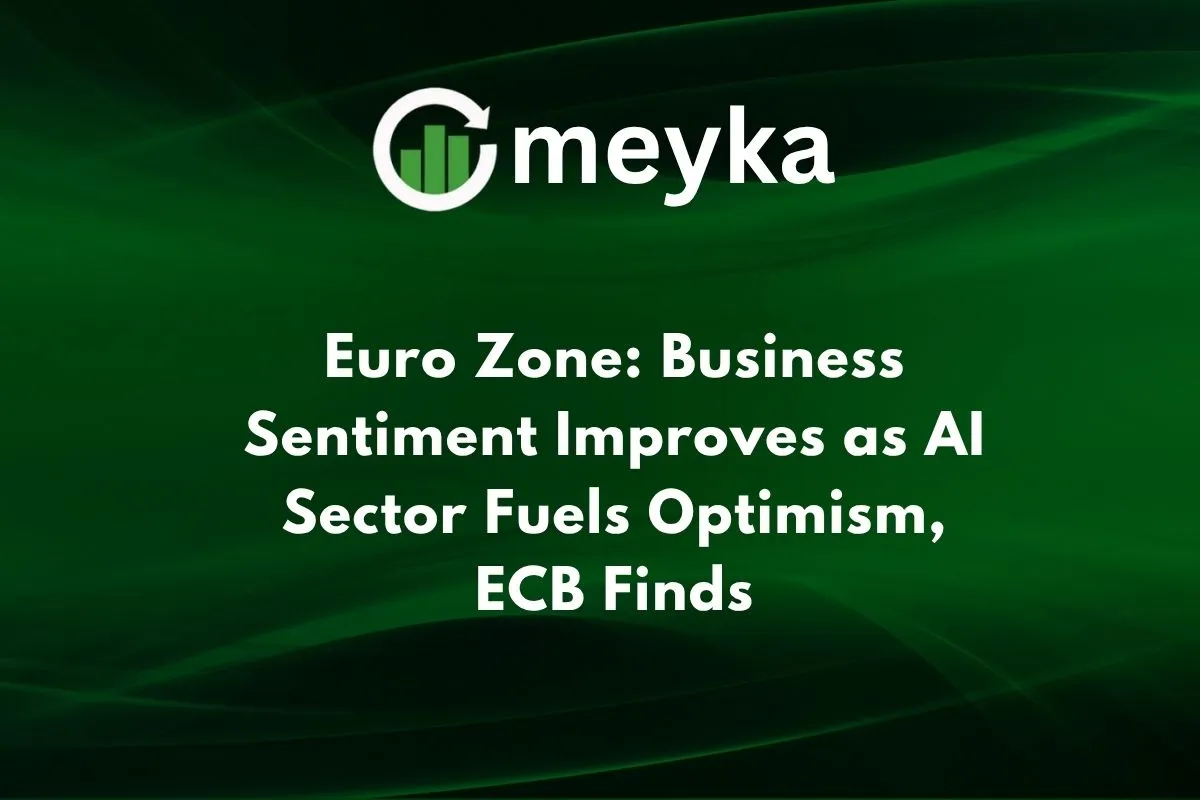Euro Zone: Business Sentiment Improves as AI Sector Fuels Optimism, ECB Finds
Business confidence in the Euro Zone is quietly turning a corner. A recent survey by the European Central Bank (ECB) shows firms feel more hopeful as digital tools and artificial intelligence reshape growth paths.
We can see the mood shift from concern about inflation and weak demand, toward talk of smarter machines, automation, and data-driven decisions. Across Germany, France, Spain, and beyond, companies expect tech, especially AI, to boost productivity, cut costs,and unlock fresh innovation.
Confidence matters because when businesses believe, they invest. When confidence rises, hiring and spending can follow. The ECB’s findings hint the Euro Zone may be entering a new phase: one where innovation and digital ambition join traditional policy levers. In this article, we explore what’s driving this trend, how the AI boom fits in, and what it means for workers, investors, and the wider economy.
Recent ECB Survey Insights
The ECB’s late business survey reveals modest but meaningful improvement in sentiment within the Eurozone. The Economic Sentiment Indicator (ESI) rose by 1.2 points in October 2025, reaching 96.8 for the euro area. Inflation is expected to stay close to the ECB’s 2 % target in the coming years. GDP growth for 2025 is projected at about 1.2%, then 1.0% in 2026, and 1.3 % in 2027.
The ECB noted that improved business confidence could stimulate private investment. So although growth is modest, the mood is lifting. And that matters. Business leaders who believe in the future may act differently, investing more, hiring more, and planning further ahead.
AI Boom & Tech Investment Momentum
One of the biggest reasons optimism is growing in the Euro Zone: the rise of artificial intelligence. A survey of European CEOs found that many see AI, M&, A, and geopolitics as key growth levers.
Under the EU’s “AI Continent” strategy and the EU AI Act, the bloc aims to ramp up investment in AI infrastructure, software, and cloud systems.
In simpler words, companies across the Euro Zone are upgrading: data tools, automation, and machine-learning platforms. That brings hope. Because productivity could rise. Because new business models arise.
It’s not just hype. Tech demand globally is strong. In Q3 2025, global markets were boosted by AI and tech momentum. So the Euro Zone is not isolated. It can ride that wave too.
For businesses, this means they see opportunities: smarter operations, faster decisions, less waste. And that helps confidence.
Sector-Wise Breakdown of Business Confidence
Let’s break down how different sectors in the Eurozone are feeling.
- Manufacturing: Factories are integrating robotics, sensor-driven systems, and AI-based maintenance. While still challenged by weak global demand, automation offers a buffer. The ECB noted industrial firms expect more stable conditions.
- Services: This includes finance, health care, logistics, and retail.
- Many firms here are heavy users of AI: chatbots, data analytics, and logistics optimization. The fact that service-sector companies expect stronger demand fuels overall business sentiment.
- SMEs (small & mid-sized firms): Many smaller companies in the Euro Zone are still cautious. But digital adoption is rising, and that supports optimism. The European Investment Bank survey found 86 % of EU firms still plan to invest.
- Export expectations: The Euro Zone’s open trade links matter. Firms that serve global tech markets expect growth. But risks remain: weak external demand and tariffs still weigh.
In short, while growth is not booming, sectors that embed AI and digital tools show a stronger mood and potential.
LaborMarket Impact
What does all this mean for workers? On the one hand, AI can boost job creation. New roles in data science, AI support, and automation specialists are growing. On the other hand, automation can displace routine jobs. The balance depends on how fast companies train staff and adapt. In the Eurozone, labor markets remain relatively resilient. The ECB projects employment growth at 0.6 % in 2025, with unemployment moving toward 6.0 % by end-2027.
Training and upskilling matter a lot here. If workers can shift into higher-value roles, the AI steel-up becomes inclusive. If not, gaps widen. We should watch wage pressures and productivity: the ECB sees unit-labor-cost growth falling as productivity improves.
So the story for labor is mixed: exciting new jobs, but some risk of mismatch. For businesses, stronger productivity means better margins. For workers, it means staying adaptable and learning.
Challenges & Risks Ahead
While sentiment is improving, big risks remain in the Eurozone:
- Inflation & interest rates: Although inflation is stabilizing near 2 %, it could creep higher. The ECB kept rates unchanged at 2.0 % recently. If inflation or wage costs spike, growth gets squeezed.
- AI regulation and ethics: The EU’s AI Act and other rules aim to safeguard rights, but unclear rules could delay investment or innovation.
- Talent shortage & brain drain: European firms say they face skills gaps. That limits how fast they can benefit from AI.
- External shocks: Trade tensions, weak foreign demand, and geopolitical risks still hover. The IMF states growth will remain moderate due to these headwinds.
- Slow growth base: The Euro Zone is still growing slowly. A 0.2 % quarterly growth in Q3 2025 was recorded. So the improved sentiment must translate into real results.
We should remain cautiously optimistic: the mood is up, but the path ahead is uneven.
Investor & Market Sentiment
Business mood influences markets. Because when companies expect growth, investors react. In Q3 2025, global markets enjoyed gains tied to tech and AI demand. In the Euro Zone, the improved confidence survey by the CB (and others) may lead to more investment flows into European tech, infrastructure, and innovation sectors.
Venture capital and private equity are shifting more resources into European AI startups and scale-ups. The EU’s regulatory push and AI infrastructure spending help. For investors, the foundation for stronger growth is forming.
Still, risks remain. Commodity shocks, currency swings, and weak global growth all affect the Eurozone. Therefore, market optimism is tempered and selective.
Outlook for 2025 and Beyond
What lies ahead for the Eurozone?? Let’s map a few possibilities.
- Growth: The ECB projects real GDP growth of 1.2 % for 2025, then slowing to 1.0 % in 2026, and recovering to 1.3 % in 2027. That is modest but positive.
- Business confidence: If AI adoption, digital investment, and infrastructure spending continue, sentiment may keep rising.
- Investment boost: The combination of stable financing conditions, government spending, and tech investment may lift business investment over time.
- Policy stance: The ECB is holding rates now. It sees risks as balanced but will watch inflation and growth carefully.
- Tech advantage: Europe’s push into AI, cloudand digital infrastructure may yield competitive gains. The “AI Continent” strategy is one piece.
In sum: we are likely to see a slow but steady climb, not a surge. The key will be turning positive sentiment into concrete investment, hiring, and productivity gains.
Conclusion
In the Eurozone, business moods are improving. The ECB survey shows firms are more hopeful. AI and digital transformation are at the heart of this shift. While growth remains moderate, the spark of optimism is real. Companies that embrace technology, train their staff, and build for the future are likely to benefit.
However, risks remain. Slow growth, global headwinds, regulation, and talent shortages mean the path ahead isn’t smooth. But if we, as business leaders, workers, and policymakers, focus on digital readiness and inclusive growth, the Eurozone may steer its economy into a more resilient, innovative era.
The story of the Euro Zone in 2025 is one of cautious optimism, driven by AI, grounded in reality, and open to possibility.
FAQS
The Euro Zone is growing only about 1.1-1.2 % this year. Because growth is weak, the ECB may be tempted to cut rates further. But it remains cautious due to inflation and financial risks.
Among many fields, the healthcare industry stands out as gaining the most from AI adoption. It has rich data, high needs for automation, and major room for innovation in treatment, diagnosis, and drug discovery.
The Euro Zone benefits from a single currency, which makes trade easier between member countries, reduces exchange-rate risks, and promotes price stability. These advantages help businesses invest, people move, and economies integrate more smoothly.
Disclaimer:
The content shared by Meyka AI PTY LTD is solely for research and informational purposes. Meyka is not a financial advisory service, and the information provided should not be considered investment or trading advice.






